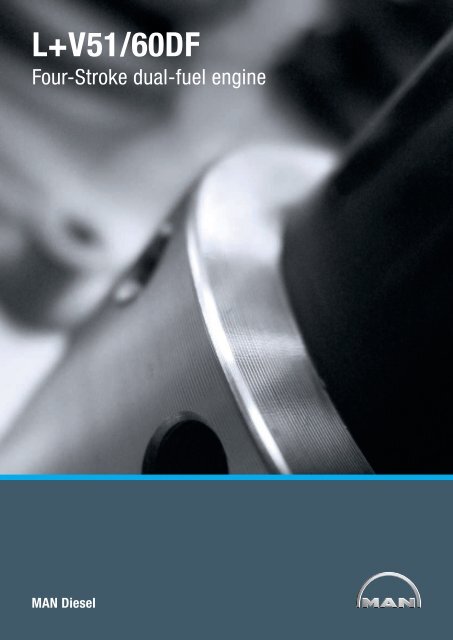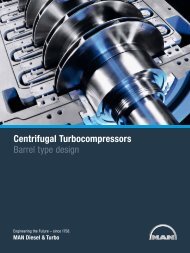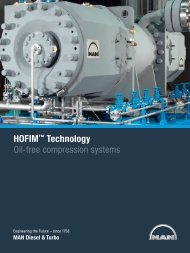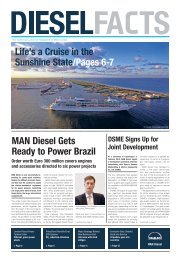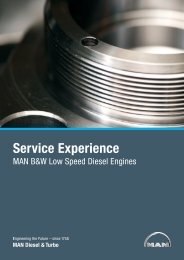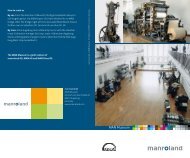L+V51/60DF - MAN Diesel & Turbo - 首页
L+V51/60DF - MAN Diesel & Turbo - 首页
L+V51/60DF - MAN Diesel & Turbo - 首页
Create successful ePaper yourself
Turn your PDF publications into a flip-book with our unique Google optimized e-Paper software.
<strong>L+V51</strong>/<strong>60DF</strong><br />
Four-Stroke dual-fuel engine<br />
<strong>MAN</strong> <strong>Diesel</strong>
<strong>MAN</strong> <strong>Diesel</strong><br />
The responsible way in leading technology<br />
<strong>MAN</strong> <strong>Diesel</strong> is the world’s leading designer and manufacturer of low and medium<br />
speed engines – engines from <strong>MAN</strong> <strong>Diesel</strong> cover an estimated 50% of the power<br />
needed for all world trade. We develop two-stroke and four-stroke engines, auxiliary<br />
engines, turbochargers and propulsion packages that are manufactured both<br />
within the <strong>MAN</strong> <strong>Diesel</strong> Group and at our licensees.<br />
More than ever before, <strong>MAN</strong> <strong>Diesel</strong>’s development focus is the environmental per-<br />
formance of our engines. Using our unrivalled grasp of large engine technology, we<br />
aim to make our engines progressively cleaner, more powerful and more efficient.<br />
Our absolute commitment to reducing emissions while increasing fuel efficiency<br />
and power density starts with our active partnership in the emissions law making<br />
process and ends with the delivery of engines that achieve an ideal synthesis of<br />
prime mover characteristics.<br />
51/<strong>60DF</strong> – Four-Stroke dual-fuel engine 3
Efficient and Compact<br />
51/<strong>60DF</strong> – The clean choice<br />
Combining diesel and gas in one engine gives you the full flexiblity in fuel usage.<br />
To imply the selection between diesel or gas fuel makes your engine running more<br />
and more economical and the possibilities of high power output with low emissions<br />
are trend-setting.<br />
Committed to the future<br />
Technologies which promise compliance with the IMO<br />
Tier III round of emissions limits due in 2016 combined<br />
with further optimised fuel consumption and new levels<br />
of power and flexibility are already under development<br />
at <strong>MAN</strong> <strong>Diesel</strong>. With this level of commitment <strong>MAN</strong><br />
<strong>Diesel</strong> customers can plan with confidence.<br />
Core technologies in-house<br />
As well as its expertise in engine design, development<br />
and manufacture <strong>MAN</strong> <strong>Diesel</strong> is also a leading manufacturer<br />
of the key technologies which determine the<br />
economic and ecological performance of a diesel and<br />
gas engine:<br />
High-efficiency exhaust gas turbochargers<br />
Advanced electronic fuel injection equipment<br />
Electronic hardware and software for engine control,<br />
monitoring and diagnosis<br />
4 51/<strong>60DF</strong> – Four-Stroke dual-fuel engine<br />
Our impressive array of computer-aided design tools<br />
and one of the engine industry’s largest, best-equipped<br />
foundries allow us decisively to shorten product<br />
development, and application engineering processes.<br />
Our mastery of these engine technologies – and, the<br />
best brains in the large engine industry – are the firm<br />
foundation for<br />
Low emissions<br />
Low operating costs<br />
Low life cycle costs<br />
Long service life<br />
The range of technical measures employed comprises:<br />
Improved charge air cooling<br />
Enhanced turbocharging<br />
Miller valve timing<br />
Revised injection timing<br />
Higher compression ratios<br />
Low swirl inlet ports<br />
Variable valve timing (VVT)
Gaseous fuels<br />
On natural gas, the 51/<strong>60DF</strong> undercuts IMO Tier II<br />
levels by extremely wide margin – indeed, in gaseous<br />
fuel mode, the 51/<strong>60DF</strong> already fulfils the strict IMO<br />
Tier III NOx limitations prescribed for Emissions Control<br />
Zones (ECA’s).<br />
Micropilot ignition<br />
Building on this firm basis for low emissions, the<br />
51/<strong>60DF</strong> employs the latest “micropilot” gas ignition<br />
technology. The gaseous fuel is ignited by injection of a<br />
distillate fuel pilot representing less than 1% of the<br />
quantity of liquid fuel needed to achieve the 51/<strong>60DF</strong>’s<br />
full rated output in its liquid fuel back-up mode.<br />
Liquid fuels<br />
The 51/<strong>60DF</strong> complies with IMO Tier II NOx emissions<br />
limits operating on either distillate (MDO) or heavy fuel<br />
oils (HFO).<br />
RI – Retarded injection<br />
Retarded injection timing delays combustion heat<br />
release and thus lowers combustion chamber temperature<br />
peaks.<br />
Common rail pilot-fuel injection<br />
The 51/<strong>60DF</strong> pilot injection system uses the latest <strong>MAN</strong><br />
<strong>Diesel</strong> common rail technology which allows flexible<br />
setting of injection timing, duration and pressure for<br />
each cylinder. This flexibility allows the fuel consumption<br />
and emissions of the 51/<strong>60DF</strong> to be optimised at any<br />
point on its operating profile. In gaseous fuel mode<br />
<strong>MAN</strong> <strong>Diesel</strong> common rail technology also allows the<br />
gas admission and pilot injection of the 51/<strong>60DF</strong> to be<br />
very closely matched to power demand, even down<br />
to very low engine loads, e.g. when meeting only the<br />
vessel’s hotel load. Likewise, <strong>MAN</strong> <strong>Diesel</strong> common rail<br />
technology also allows the 51/<strong>60DF</strong> to respond rapidly<br />
to combustion knocking and misfiring on a cylinder-bycylinder<br />
basis.<br />
ICC – Intrinsically clean combustion<br />
The 51/<strong>60DF</strong> is designed to burn methane and gases<br />
with high methane content. As the simplest compound<br />
of carbon and hydrogen in the hydrocarbon series,<br />
methane is essentially clean burning.<br />
51/<strong>60DF</strong> – Four-Stroke dual-fuel engine 5
Engine Specifications<br />
51/<strong>60DF</strong> – “The reliable engine”<br />
The synonym for top performance with the highest level of flexibility. The per-<br />
formance of this potent marine engine lies in a range from 6,000 to 18,000 kW.<br />
For LNG carriers the 51/<strong>60DF</strong> is the right choice in every respect.<br />
General<br />
The 51/<strong>60DF</strong> engine from <strong>MAN</strong> <strong>Diesel</strong> SE is a dual-<br />
fuel marine engine that converts diesel fuel or natural<br />
gas into electrical or mechanical propulsion power efficient-<br />
ly and with low emissions. In combination with a safety<br />
concept designed by <strong>MAN</strong> <strong>Diesel</strong> SE for appli cations<br />
on LNG carriers, the multi-fuel capability of the engine<br />
represents an appropriate drive solution for this type<br />
of vessel, as well as for other marine applications. The<br />
capability to change over from gas to diesel operation<br />
with out interruption rounds off the flexible field of appli-<br />
cation of this engine.<br />
51/<strong>60DF</strong> now for both<br />
electrical and mechanical propulsion<br />
The 51/<strong>60DF</strong> engine is now also available for mechanical<br />
propulsion in a wide range of applications. Compared<br />
to the diesel-electric concept, the mechanical drive<br />
concept leads to a higher total efficiency and lower<br />
investment costs of the ship’s propulsion train.<br />
6 51/<strong>60DF</strong> – Four-Stroke dual-fuel engine<br />
Fuels<br />
The 51/<strong>60DF</strong> engine is designed for operation with<br />
liquid and gaseous fuels. In gas operation, the gas to<br />
be burnt has to meet the latest applicable <strong>MAN</strong> <strong>Diesel</strong><br />
directives for natural gas. In diesel mode, the 51/<strong>60DF</strong><br />
engine can run on heavy fuel oil up to a viscosity of<br />
700 mm²/s (cSt) at 50 ˚C. It is designed for fuels up<br />
to and in cluding the specification CIMAC 2003 H /<br />
K700 / DIN ISO 8217. In diesel mode, uninterrupted<br />
heavy fuel oil operation is possible in a power range<br />
from 100% to 20% and even below 20% for limited<br />
periods.<br />
Marine main propulsion engines<br />
Engine output is limited to 100% of rated output for<br />
engines driving propellers. Engine output is limited to<br />
110% of rated output for engines driving a generator.<br />
Overload above 100% load is permitted briefly to prevent<br />
a frequency drop during sudden load imposition<br />
in generator applications.<br />
Marine auxiliary engines<br />
Fuel stop power is 110% of rated output. Overload<br />
above 100% may only be used briefly to balance out<br />
fluctuations in frequency during load acceptance in<br />
diesel and gas modes.
Technical Specifications<br />
Quality inside<br />
Engine frame<br />
Rigid housing in monoblock design (cast) with full<br />
length tie-rods from suspended main bearing to upper<br />
surface of engine frame and tie-rods from cylinder<br />
head to intermediate bottom.<br />
Cylinder liner<br />
The cylinder liner, mounted in individual cylinder jacket,<br />
is free of deformations arising from the engine frame<br />
and thus assures optimum piston running, i.e. high<br />
service life and long service intervals.<br />
Con-rods and con-rod bearings<br />
Optimised marine head version with split joint in upper<br />
shaft area, thus no release of the con-rod bearing necessary<br />
during piston extraction; low piston extension<br />
height. Optimised shells for con-rod bearings increase<br />
operating safety.<br />
Stepped pistons<br />
Forged steel crown highly resistant to deformation (with<br />
shaker cooling) made from high grade material and<br />
nodular cast iron in lower section; In combi nation with<br />
a flame ring, the stepped pistons prevent undesirable<br />
“bore polishing” on the cylinder liner – and assure<br />
permanently low lubricating oil consumption, i.e. low<br />
operating costs. Chrome ceramic coating of first piston<br />
ring with wear resistant ceramic particles in ring surface<br />
results in low wear, i.e. long service life and long service<br />
intervals.<br />
8 51/<strong>60DF</strong> – Four-Stroke dual-fuel engine<br />
Cylinder head<br />
With its combustion chamber geometry, the cylinder<br />
head assures optimum combustion of gas and diesel<br />
fuels. Atomisation of the fuel spray in both operating<br />
modes is unimpeded – thus leading to very good air:<br />
fuel mixture formation and an optimum com bustion<br />
process, i.e. reduction in fuel consumption in both ope-<br />
rating modes.<br />
Valves<br />
The exhaust valves have water-cooled, armoured<br />
exhaust valve seat rings and thereby low valve temperatures.<br />
Pro pellers on the exhaust valve shaft cause<br />
rotation of the valve due to the gas flow with resultant<br />
cleaning effect of the sealing surfaces. The inlet valves<br />
are equipped with Rotocaps. This results in a low rate<br />
of wear, i.e. long service intervals.<br />
Injection<br />
High pressure injection in liquid fuel mode with improved<br />
atomisation for combustion of fuels with the<br />
lowest quality still accepted. In gas mode, ignition is via<br />
injection of a small quantity of pilot fuel by means of a<br />
common rail system. Overall, a fuel injection system<br />
optimised for low consumption and harmful emissions.<br />
Rocker housing<br />
Modified, weight-reduced rocker arm casing allows<br />
quick replacement of injectors in gas and diesel modes.<br />
The components required for gas operation are completely<br />
integrated into the rocker housing. High design<br />
strength, good heat dissipation and a configuration<br />
for the highest ignition pressures ensure that the unit<br />
has a very high level of component safety, i.e. long<br />
service life.
51/<strong>60DF</strong> – Four-Stroke dual-fuel engine 9
Technical Specification<br />
Modern and innovative technology<br />
<strong>MAN</strong> <strong>Diesel</strong> charging system<br />
Optimally adapted charging system (constant pressure)<br />
with modern <strong>MAN</strong> <strong>Diesel</strong> turbochargers from the<br />
TCA series having long bearing overhaul intervals and<br />
high efficiency. Good part load operation thanks to<br />
very high turbocharger efficiency even under low pressure<br />
conditions. The V51/<strong>60DF</strong> engines are charged<br />
by just one TCA turbocharger, which means that only<br />
one common exhaust gas collector pipe is required<br />
for all cylinders.<br />
Service-friendly design<br />
Hydraulic tools for tightening and loosening cylinder<br />
head nuts; Quick locks and/or clamp and stub connections<br />
on pipes/lines; Generously sized crankcase<br />
cover; Hydraulic tools for crankshaft bearings and<br />
lower con necting rod bearings; Very low main tenance<br />
Geislinger sleeve spring vibration dampers.<br />
SaCoS one<br />
The 51/<strong>60DF</strong> is equipped with the Classification So-<br />
ciety compliant safety and control system SaCoS one .<br />
The SaCoS one control system allows safe engine opera-<br />
tion in diesel and gas modes with optimum consump-<br />
tion and emissions. In gas mode, the SaCoS one control<br />
system guarantees safe operation between the knock<br />
and misfire boundaries. All cylinders are controlled<br />
individually in this instance. In diesel mode, control is<br />
based on the tried and tested management system.<br />
This system is subject to a test-run in the factory with<br />
the engine so that fine tuning and functional testing<br />
during commissioning in the vessel only involve a<br />
minimum of effort.<br />
10 51/<strong>60DF</strong> – Four-Stroke dual-fuel engine<br />
Soot<br />
Soot emissions during operation on liquid fuel have<br />
been reduced by means of optimised combustion and<br />
turbo charging. For use in areas where soot emissions<br />
can lead to problems during uninterrupted operation<br />
at below 20% output and at idle, special auxiliary<br />
equipment is offered that prevents the production visible<br />
smoke. In gas mode there are no problems with<br />
soot emissions.<br />
Fuel Sharing<br />
The 51/<strong>60DF</strong> is optional available with the innovative<br />
FUEL SHARING feature. This means that mixtures of<br />
Gas and HFO can be simultaneously burned in a single<br />
engine. This feature offers total fuel flexibility to the<br />
operator of a LNGC.<br />
Low-load operation in gas mode<br />
The State-Of-The-Art 51/<strong>60DF</strong> offers as an additional<br />
optional feature a high operational flexibility to the<br />
customer. The so called low-load capability enables<br />
the customer to operate the 51/<strong>60DF</strong> even on loads<br />
below 15% MCR in gas mode for a noticeable duration.<br />
This technical ability can be realized by using the<br />
newest <strong>MAN</strong> <strong>Diesel</strong> turbocharger technology which is<br />
called VTA (variable turbine area).
Engine data for 51/<strong>60DF</strong><br />
General<br />
Engine cycle: Four-stroke<br />
<strong>Turbo</strong>charging system: Constant pressure<br />
No. of cylinders, in-line engine: 6, 7, 8, 9<br />
No. of cylinders, V-engine: 12, 14, 16, 18<br />
Bore: 510 mm<br />
Stroke: 600 mm<br />
Swept volume per cyl.: 122.6 dm3 Power-to-weight ratio (MCR)<br />
In-line engine: 16.4 – 17.6 kg/kW<br />
V-engine: 14.7 – 15.7 kg/kW<br />
Cylinder output (MCR)<br />
at 514 rpm: 1,000 kW<br />
at 500 rpm: 975 kW<br />
Cooling<br />
Cylinder cooling (one-stage): Fresh water<br />
Charge-air cooler (two-stage): Fresh water<br />
Fuel injector cooling: Fresh water<br />
Starting method: Compressed air<br />
General performance definition for diesel and<br />
dual-fuel engines as per ISO 3046/1-2002<br />
ISO reference conditions:<br />
Air temperature: 298 K (25°C)<br />
Air pressure: 1 bar<br />
Fresh water temperature upstream of charge-air<br />
cooler: 298 K (25°C) Relative humidity: 30%<br />
No power reduction required below:<br />
Air temperature: 318 K (45°C)<br />
Air pressure: 1 bar<br />
Fresh water temperature upstream of charge-air<br />
cooler: 311 K (38°C) Relative humidity: 50%<br />
In gas operation<br />
Methane value ≥ 80<br />
Lower calorific value of gas ≥ 28.0 MJ/m<br />
*) Values in m 3 N at 0°C and 1,013 bar<br />
3N *)<br />
IMO requirements<br />
The engine detailed herein will comply with the<br />
emission limits refered to as IMO Tier II.<br />
The fuel consumption is based on a lower calorific value (LHV) of the fuel of<br />
42,700 kJ/kg without engine driven pumps. Tolerance 5%. Lubricating oil<br />
consumption value is given with a tolerance of 20%.<br />
51/<strong>60DF</strong> – Four-Stroke dual-fuel engine 11
Technical Data<br />
51/<strong>60DF</strong><br />
Specific fuel consumption<br />
100% load 85% load<br />
L+V 51/<strong>60DF</strong> (gaseous fuel) 7,260 kJ/kWh 7,400 kJ/kWh<br />
L+V 51/<strong>60DF</strong> (liquid fuel) 184 g/kWh 183 g/kWh<br />
Specific lubricating oil consumption<br />
g/kWh<br />
<strong>L+V51</strong>/<strong>60DF</strong> 0.5<br />
Outputs MCR (maximum continuous rating)<br />
Engine speed 514 rpm 500 rpm<br />
Mean piston speed 10.3 m/s 10.0 m/s<br />
Mean effective pressure 19.05 bar 19.05 bar<br />
12 51/<strong>60DF</strong> – Four-Stroke dual-fuel engine<br />
kW / bhp<br />
6L51/<strong>60DF</strong> 6 cyl. 6,000 / 5,850<br />
7L51/<strong>60DF</strong> 7 cyl. 7,000 / 6,825<br />
8L51/<strong>60DF</strong> 8 cyl. 8,000 / 7,800<br />
9L51/<strong>60DF</strong> 9 cyl. 9,000 / 8,775<br />
12V51/<strong>60DF</strong> 12 cyl. 12,000 / 11,700<br />
14V51/<strong>60DF</strong> 14 cyl. 14,000 / 13,650<br />
16V51/<strong>60DF</strong> 16 cyl. 16,000 / 15,600<br />
18V51/<strong>60DF</strong> 18 cyl. 18,000 / 17,550
Dimensions and Weights<br />
Engine programm<br />
In-line engine L51/<strong>60DF</strong> V-engine V51/<strong>60DF</strong><br />
In-line engine L51/<strong>60DF</strong><br />
Engine type No. of cyl. L L 1 W H Weight<br />
mm mm mm mm t<br />
6L51/<strong>60DF</strong> 6 8,494 7,455 3,165 5,360 106<br />
7L51/<strong>60DF</strong> 7 9,314 8,275 3,165 5,360 119<br />
8L51/<strong>60DF</strong> 8 10,134 9,095 3,165 5,360 135<br />
9L51/<strong>60DF</strong> 9 11,160 9,915 3,283 5,360 148<br />
V-engine V51/<strong>60DF</strong><br />
Engine type No. of cyl. L L 1 W H Weight<br />
mm mm mm mm t<br />
12V51/<strong>60DF</strong> 12 10,254 9,088 4,720 5,420 189<br />
14V51/<strong>60DF</strong> 14 11,254 10,088 4,720 5,420 213<br />
16V51/<strong>60DF</strong> 16 12,254 11,088 4,720 5,420 240<br />
18V51/<strong>60DF</strong> 18 13,644 12,088 4,720 5,420 265<br />
All weights and dimensions are for guidance only and apply to dry engines without flywheel.<br />
Minimum centreline distance for twin engine installation: In-line engine: 3,800 mm, V-type engine: 4,800 mm<br />
More information available upon request.<br />
51/<strong>60DF</strong> – Four-Stroke dual-fuel engine 13
World Class Service<br />
Marine propulsion and GenSets<br />
PrimeServ – peace of mind for life<br />
With more than 150 PrimeServ service stations and<br />
service partners worldwide, plus our growing network<br />
of PrimeServ Academies, the <strong>MAN</strong> <strong>Diesel</strong> after-sales<br />
organisation is committed to maintaining the most<br />
efficient and accessible after-sales organisation in the<br />
business.<br />
PrimeServ’s aim is to provide:<br />
Prompt delivery of high demand OEM spare parts<br />
within 24 hours<br />
Fast, reliable and competent customer support.<br />
Individually tailored O&M contracts<br />
Ongoing training and qualification of service personnel.<br />
Global service, open 24 hours-a-day, 365 days-a-year<br />
Diagnosis and troubleshooting with our high perfor-<br />
mance Online Service.<br />
14 51/<strong>60DF</strong> – Four-Stroke dual-fuel engine<br />
The PrimeServ Offering<br />
Based on almost 110 years of service experience with<br />
marine <strong>Diesel</strong> engines, our sophisticated logistics system<br />
ensures that all frequently requested spare parts<br />
are available worldwide within 24 hours. In addition,<br />
<strong>MAN</strong> <strong>Diesel</strong> Online Service helps to optimise maintenance<br />
cycles by the use of remote engine monitoring,<br />
diagnostics and calibration. The resulting conditionbased<br />
maintenance (CBM) promotes high availability,<br />
increases operational safety, shortens downtimes and<br />
enhances the performance of <strong>MAN</strong> <strong>Diesel</strong> marine engines.<br />
The bottom line: leaner operating costs and better<br />
planning for you.<br />
When service is required, the <strong>MAN</strong> <strong>Diesel</strong> PrimeServ<br />
network responds to organise assistance as fast as<br />
possible. This guarantees rapid completion of maintenance<br />
work and high availability of <strong>MAN</strong> <strong>Diesel</strong> engines,<br />
GenSets, turbochargers, gears, propellers and marine<br />
propulsion packages.<br />
In short: <strong>MAN</strong> <strong>Diesel</strong> PrimeServ gives you the benefit<br />
of our specialist expertise in marine power so that you<br />
can concentrate on your own core business.
<strong>MAN</strong> <strong>Diesel</strong><br />
86224 Augsburg, Germany<br />
Phone +49 821 322-0<br />
Fax +49 821 322-3382<br />
marineengines@mandiesel.com<br />
www.mandiesel.com<br />
<strong>MAN</strong> <strong>Diesel</strong> – Powering the World<br />
Copyright © <strong>MAN</strong> <strong>Diesel</strong><br />
• Subject to modification in the interest of technical progress. • D2366336EN-N5 Printed in Germany KW9-12091


